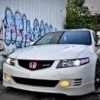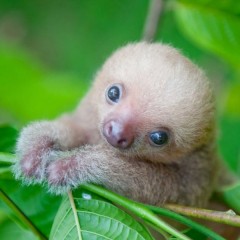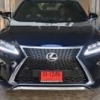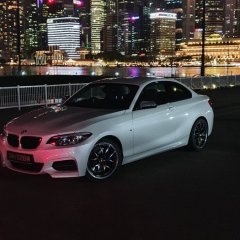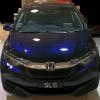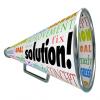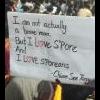Search the Community
Showing results for tags 'drinks'.
-
I’m back! Wine Connection with @SiLangKia @Carbon82 @RadX ❤️
-
Hi all, I just found 4 packs of instant noodles in my cabinet which have expired on Nov last year. However they are not opened yet and I googled in some sites that it is safe to eat because they are dehydrated food and bacteria won't grow inside. The MSG is salt and so won't get spoil too. So should I eat them or throw away?
- 568 replies
-
- 1
-

-
- expired food
- wastage
- (and 5 more)
-
These days, it’s not only your assignments that will be graded: even your drinks will also be graded as well. With the Ministry of Health (MOH) latest “drink grading system”, you’ll be able to easily tell which drinks are the healthiest with just a glance. From 30 December 2022, when we’ve all probably taken 20 booster jabs, all drinks will be graded with either an A, B, C or D, with A being the healthiest and D being the unhealthiest. All drinks, including soft drinks, fruit juices and juice drinks, milk and yogurt drinks, and even instant powdered beverages, will receive a grade, specifically, “Nutri-Grade” The drinks will also have a nutrition label specifying: Energy value Amounts of protein Carbohydrate Fat Total Sugar Saturated Fat D-Grade Cannot be Advertised Just like your failing grades, the drinks with D-grade cannot be advertised on media platforms. However, if you were to go into a store with such drinks, they can still be advertised with posters. Drinks graded with C or D will also be required to carry the Nutri-Grade mark on the front of the packaging. If the drinks are sold in a vending machine, in a dispenser or online, the grades will have to be displayed in a prominent manner. In short, the grades have to be visible and not hidden at a corner, under the can or worse, in the can. Why the Graded Drinks? The new changes are implemented to help consumers identify beverages lower in sugar and saturated fats. This help consumers make more informed decisions in hopes of them making healthier choices. Additionally, they do not want the media to advertise consumer preferences on unhealthy drinks anymore. This will spur industry reformulation aka no more clickbaity drinks advertisements. The Government Gazette has published the regulations and it will come into force a year later. This period of time was given to help companies adapt to the new requirements and reformulate their products to a healthier version. If these companies still refuse to put the grades on their drinks by the end of next year, they will be fined a maximum of S$1,000 if they are first-time offenders. If they still did not learn their lesson after the first offence, they will be fined up to S$2,000. Source: https://goodyfeed.com/drink-graded/
- 74 replies
-
- 8
-

-
.png)
-
- drinks grading
- drinks
-
(and 1 more)
Tagged with:
-
SINGAPORE - Singapore may well become the first country in the world to ban the sale of packaged drinks with high sugar content. This is one of the moves the Ministry of Health (MOH) is contemplating in its efforts to cut the high sugar intake of people here, as it is a major factor for obesity and diabetes. The MOH and the Health Promotion Board are asking people for their views on four measures to cut sugar intake from drinks, which include 3-in-1 mixes, cordials, yogurt drinks, fruit juices and soda drinks. The target is on drinks as they account for more than half the 12 teaspoons of sugar people here take each day. One in four sugar-sweetened beverages contains 5.5 teaspoons of sugar or more. The four measures the MOH wants public feedback on are: - Total ban on pre-packed high-sugar drinks - Single or tiered tax on high-sugar drinks - Mandatory front-of-pack labelling on sugar/nutrition content - Ban on advertisements on all platforms for high-sugar drinks, including social media and on buses Singapore already does not allow the sale of high-sugar drinks in schools and on government premises. Many companies also refrain from advertising high-sugar drinks during the hours when children are more likely to be watching television. There is also the Healthier Choice Symbol to identify healthier drinks. But this, too, is voluntary. The public consultation is to gauge people's reactions to pushing these boundaries further. In a press statement, the MOH said that every 250ml of sugar-sweetened beverages daily raises a person's risk of getting diabetes by 18 per cent to 26 per cent. This is from various studies, so the amount of sugar in the drink was not indicated. The World Health Organisation (WHO) encourages people to take as little sugar as possible as "nutritionally, people do not need any sugar in their diet". It said reducing sugar intake to 25g a day would provide health benefits. This is equal to five teaspoons as measured in Singapore, but six teaspoons according to the WHO. Experts The Straits Times spoke to all agreed that a total ban on high-sugar drinks would be the most effective, but also the least politically palatable measure. Professor Teo Yik Ying, dean of the Saw Swee Hock School of Public Health, said the four measures are not mutually exclusive and together, are "very much in the right direction". He added that any reduction in sugar intake will directly translate to health benefits. Both he and Professor Eric Finkelstein of the Duke-NUS Medical School agree that packaged fruit juices, even those with no added sugar, should not be exempt. Prof Finkelstein said sugar is sugar, adding that the narrower the tax, the less effective it is as people can still have other high-calorie drinks as substitutes. Dr Kalpana Bhaskaran, a glycaemic expert from Temasek Polytechnic, said a 330ml can of soda and one of apple juice have about 36g of sugar each. Ms Gladys Wong, a senior principal dietitian at the Khoo Teck Puat Hospital, thinks the suggested measures do not go far enough. She said: "There must be a fair way to tax the freshly prepared beverage outlets, not just the pre-packaged drinks." Professor Rob van Dam, an epidemiologist at the Saw Swee Hock School of Public Health, said high sugar content in drinks adds calories but does not make people feel full, so it is worse than sugar in food. He said a study in Mexico estimated that a 20 per cent reduction in sugar would reduce obesity by 12.5 per cent. Being overweight or being obese are key risk factors for diabetes, heart attacks, stroke and some cancers, he added. The public can give feedback at www.reach.gov.sg/sugarydrinks or e-mail [email protected] from now till Jan 25 next year.
-
We have read about kind hearted residents providing free wifi for workers, giving them free food and drinks when the workers are working for them (upgrading project included), but this one really take the cake! The perks of being rich. Source: https://sg.news.yahoo.com/singapore-family-vending-machine-free-drinks-workers-031548465.html A family residing in Siglap has set up a drinks-vending machine outside their home, so that food deliverymen and other workers can enjoy free drinks. According to The Straits Times, Eric Chiam and his wife developed this vending machine idea with their triplet children, Andre, Ethan, and Sophia. They called this family project "TYVMdrinks" or "Thank You Very Much drinks", said Chiam in a LinkedIn post on Friday (3rd March). Each of the family members had specific roles. Chiam's son wrote the first ideas and critical considerations in a Google Doc, while his other son designed the logo and vending machine stickers. His daughter manages the Instagram account, his wife orders the drinks and Chiam himself funds the project. Although he had initially intended to store drinks in a fridge by the gate of his home at Yarrow Gardens, he encountered "significant difficulty" in constructing a shelter. As a result, they decided to install a vending machine that can keep beverages cold and withstand outdoor weather conditions. During its first month of operation in January, the machine dispensed 637 drinks to food deliverymen, postal workers, and anyone else coming by on a work errand. Chaim pointed out that postmen and refuse truck workers use the vending machine daily. "The Grab and Lalamove guys were in two camps, some took the drinks, but others were in too much of a hurry to notice its presence," he said. "We reckon news of the drinks machine has not gone around in their WhatsApp groups much yet." On average, 21 cans of beverages would be dispensed daily. According to Chiam, green tea and 100 plus beverages were the clear favourites. The Straits Times reported that setting up and decorating the vending machine cost about $3,000, and the canned drinks cost less than 50 cents each. Besides replenishing the vending machine twice a week, the family also discusses the types and number of drinks to buy over meals and ways to improve the project. Dr Chiam suggested a pay-it-forward system to improve the project where others can chip in to purchase drinks for the delivery workers. Having kind comments about the vending machine online has been encouraging. Chiam told The Straits Times, "The most rewarding part of this project is definitely seeing the smiles of delivery men, drivers and service people who use it."
- 31 replies
-
- 19
-

-
https://asia.nikkei.com/Business/Food-Beverage/From-Thailand-to-Vietnam-Asia-acquires-taste-for-buzz-lite-alcohol?del_type=1&pub_date=20220628123000&seq_num=2 From Thailand to Vietnam, Asia acquires taste for buzz-lite alcohol COVID and rising incomes fuel demand for healthier, low-proof alternatives Men drink beer on the street in Hanoi. Vietnam is Southeast Asia's largest consumer of beer. © Reuters JUNYA HENMI, TOMOYA ONISHI and YUICHI SHIGA, Nikkei staff writersJune 28, 2022 07:12 JST TOKYO/HANOI/MANILA -- From Thailand to the Philippines, more drinkers across Southeast Asia are turning to less-potent beverages and even alcohol-free versions of their favorite drinks so that they can avoid the throbbing headaches and other unpleasantness that follows an evening of overindulgence. Suntory Holdings begins producing its Horoyoi canned cocktail in Thailand on Tuesday through local unit Thai Spirit Industry. The drink, which is also popular in Japan, contains 3% alcohol. Suntory previously imported the beverage from Japan. It plans initially to produce 10,000 cases in Thailand, in grape and peach flavors. "People have different tastes depending on the local climate and food, so thorough localization is key," said Makoto Kitaura, a marketing manager at Suntory Spirits. Suntory also produces Horoyoi in Australia. The Japanese company hopes to speed development of new beverages and flavors by producing them where they are sold, so it can better navigate the ready-to-drink industry's notoriously short product cycles. Thailand's ready-to-drink alcohol market, now dominated by wine coolers, will grow more than 20% between 2021 and 2026 to 8.53 million cases, the U.K.-based IWSR predicts. In Vietnam, Sapporo Breweries began selling a lower-alcohol version of its Premium Beer last month. Sapporo Premium Beer 100 contains 3.5% alcohol, 1.5 points less than the original. It is made from 100% malt and priced nearly 20% higher, at 19,900 dong (86 cents) per 330-milliliter can. Low-alcohol beverages are capturing more interest in Vietnam, the region's largest consumer of beer. "I try to drink beer with a lower alcohol content when I have important work commitments the next day," said Nguyen Manh Hoang in Hanoi. The 35-year-old said he also was paying more attention to his health. The alcohol-free Heineken 0.0 reached Vietnamese store shelves in 2020. Local players like Saigon Beer Alcohol Beverage, or Sabeco, also are making inroads into the field. "Nonalcoholic beer is very popular, and we're currently sold out of Heineken," said a representative at a major supermarket in Hanoi. A supermarket in Hanoi: Low-alcohol Sapporo beer went on sale in Vietnam in May. (Photo by Tomoya Onishi) Low-alcohol beverages are gaining ground in the Philippines as well, despite liquor being available for relatively cheap. San Miguel Brewery, the country's largest producer of beer, now sells fruit-flavored beers and sugar-free hard seltzer ranging from 3% to 5% alcohol, as well as the nonalcoholic San Miguel 0.0 lager. The growing demand for such beverages stems from diversifying tastes in Southeast Asia, as economic growth and rising incomes push consumers to branch out beyond beer to wine, cocktails and other beverages. The coronavirus pandemic also made consumers more health-conscious. A 2022 survey by Euromonitor International found that 12.2% of baby boomers in the Asia-Pacific drink almost daily, while only 6.3% of millennials said the same. When asked why they were cutting back, 51.4% of respondents said it was for their health. Despite its bright outlook, Southeast Asia's no- and low-alcohol market was hit hard by the coronavirus restrictions. Sales in the region's eight main countries totaled 24,800 kiloliters in 2021, shrinking 11% from 2019, according to Euromonitor. "People dine out often in Southeast Asia, so demand for drinking at home is not as strong as in Japan," said an official at a Japanese company. "With people eating out less frequently amid the pandemic, opportunities to buy no- or low-alcohol beverages decreased." Japan's Suntory Holdings starts producing the Horoyoi canned cocktail in Thailand this week through a local unit. (Photo by Junya Henmi) Stronger regulations add to the uncertainty about a full recovery in earnings at liquor companies. Vietnam, for example, introduced tougher penalties for drunken driving in January 2020. The alcohol industry also faces investors focused more on environmental, social and corporate governance factors. Those in Asia, many of whom are younger, pay particularly close attention to ESG. A poll by The Economist shows that about 70% of young investors in Singapore and China emphasize ESG, far above the roughly 40% for their counterparts in the U.S., Canada and the U.K. With promoting good health and well-being listed as one of the United Nations' 17 Sustainable Development Goals, beer and liquor producers feel pressured to demonstrate that their operations are ethical, including through expanding no- and low-alcohol offerings. Alcohol-free options are also key for beverage companies to expand their footprint, especially with Muslim-majority countries accounting for about half of Southeast Asia's population of over 600 million. Alcohol consumption is prohibited under Islam. Low-alcohol products are not the silver bullet, however. They still carry the risk of being blamed for lowering the barrier for alcohol consumption.
-
'Jackie Chan and Wong Fei-Hung' in Telok Blangah duel after too many drinks. https://stomp.straitstimes.com/singapore-seen/jackie-chan-and-wong-fei-hung-in-telok-blangah-duel-after-too-many-drinks What would happen if martial arts stars Jackie Chan and Wong Fei-Hung got into a duel? We will never know, considering how they belong to different eras. We do have a Singaporean version featuring two uncles, however. Stomper Danial spotted the two men in a dispute at Telok Blangah Rise Market on Sunday night (Nov 14), at around 8.50pm. A video that he sent to Stomp shows a man in a red shirt swinging and waving his arms animatedly while shouting at another man clad in yellow. v2 Jackie Chan Fights Wong Fei Hung In Telok Blangah Duel After Too Many Drinks -1.m4v Danial said: "This is what happens after Jackie Chan and Wong Fei-Hung have too many drinks. "They settled the dispute after the dance."
- 26 replies
-
- 10
-
.png)
-
- jackie chan
- wong fei-hung
-
(and 3 more)
Tagged with:
-
Dear all, Recently I had poured an almost full cup of sugary drink into one of my leather chair. Because the leather was perforated and had mini holes, most of the drink went inside to the car seat foam under the leather. I cleaned what I could with the leather and went for some chemical cleaning. But how to treat the foam inside? What other methods are there besides steam cleaning? Thanks
-
- 63 replies
-
- 6
-

-
- happy hour
- beer
- (and 5 more)
-
Hi Friends,my Brother in law's 1 year old Sharan 'drinks' 1.2L of coolant from new,now mileage is 12k Km,today went for 1 st service,Service Advisor told him it is normal for Turbo-charged cars to 'drink' a little coolant,which i don't think so,can any others VW car owners tell me is it true.??Esp those using the EA888 engine[GTI,GOLF R,Audi A5 or Skoda etc],thanks folks.
-
I am not that well travelled yet ... but for those who have travelled to many countries, can you tell me which countries has supermarkets that will charge you more for chilled drinks over their ambient temperature drinks - for the same product ?
-
I saw this on a facebook page I keep an eye on, and it made my laugh... So thought it worthwhile sharing here, many bros would enjoy - especially @Radx with his legendary economy in his Bimmer.... An interesting head to head - fuel use challenge between an M3 and a Prius
-
5 Places Where Drinks Are So Cheap, It’s a ProblemBy Ryan Ong in Frugal Living | Dec 3, 2013 5 Comments Life in Singapore is stressful, so there’s many occasions when I need to get plastered, even on a tight budget (e.g. stressful deadlines, impossible clients, days ending in the letter “y”). If you’re the same, keep an eye out for the places on this list. The money you save might even cover treatments for your cirrhosis: BONUS: Cheapass Tip for MoneySmart ReadersI’ve mentioned this in another article, but I’ll explain it again here. There is a possible way to get free drinks if your friends get sloshed enough, and your moral compass is more broken than your liver. Invite a group of friends out to drink with you – the more the better. Try to make it at least six people. Once the venue is agreed upon, be sure to arrive about 40 minutes late. By then, most people would have ordered a few bottles, a whole beer tower, etc. You can probably leech off the drinks already ordered, without calling for any yourself. If everyone’s sloshed enough at the end of the night, chances are good that no one will notice. For other money saving tips, you can always stay tuned with us on Facebook. 1. Five Izakaya Five Izakaya is modeled after Japan’s 300 Yen bars, which are basically just alcohol dispensers with walls. The “five” in Five Izakaya refers to the price of the drinks – you know how everything in Daiso is $2? Same concept here. Virtually every drink in this bar is $5. There are no gimmicks and no happy hours. It’s Asahi, Shochu, Choya, and various types of wine all going at $5 in the bar – anytime you walk in. Even the snacks are $5, probably because you can’t handle a more complex bill by the time you’re done. One problem though (at the Collyer Quay Outlet, I can’t speak for the others) is the food. It’s wildly inconsistent, and on some days the chicken tastes like pure mouthfuls of salt. But on most days the food is passable (And frankly, complaining about the food in a $5 bar is like complaining about the music in an elevator). There are three outlets, as described below. Pros - $5 Drinks, no specific happy hour Cons - Food can be inconsistent. Where and When: 16 Collyer Quay, #01-05B / Tel. 6536 8955 / Open from 12pm – midnight on Mon. to Fri. Open from 6pm – midnight on Sat. Closed on Sun. and Public Holidays. 5 Changi Business Park Central 1, Changi City Point, #01-66/67 / 6604 8255 / Open daily from 12 pm to midnight 25 Cuppage Road, Cuppage Terrace / Tel. 6733 8097 / Opens daily from 5pm to midnight 2. Insomnia Bar & RestaurantLet me get this out of the way: I hate a lot of the clientele at Insomnia. Many of them are younger than me, which is depressing and therefore a personality flaw on their part (send rational retorts to [email protected]). My point is, the crowd can feel a bit youngish if you’re in the 35 to 40+ age range. The music and ambiance seem catered to the young-bloods too, so the dance floor and conversation may not be too attractive. That said, the booze is free flow. From 9pm to 11pm on Wednesdays, $20 will get you all-you-can-drink from the bar. And right up till 31st December 2013, you also get 40% off standard drinks via the CHIJMES promotion. Overall, if you want to drink on a Wednesday and you know you’ll be downing a lot more than $20 worth, come to this bar. Pros – All you can drink for $20. Until 31st December 2013, 40% off standard drinks. Cons - If you’re over 35, you’ll get the odd feeling that you just gatecrashed a 16 year old’s birthday party. Where and When: #01-21 CHIJMES, 30 Victoria Street / Tel. 6338 6883 / Open from 11 am to 4 am on Sun. to Tues. Open from 11am to 5 am from Wed. to Sat. 3. Tanuki RawThis place is as much about food as it is about drinks. And as the name implies, Tanuki Raw is about raw foods – in particular oysters. During Happy Hour (5pm to 8pm), this place serves up $10 Martinis. Every martini you buy lets you purchase up to a half dozen oysters at $2 each, and a plate of salmon sashimi at $5. So two martinis means you can buy 12 oysters and two sashimi plates, and three means you can buy 18 oysters and three sashimi plates, etc. (If you actually intend to down 18+ oysters with alcohol in one sitting, read this article first) This is one of my default hangouts, so trust me when I tell you (1) the drinks are insanely strong, (2) the Steak Tartare is amazing, and (3) Dennis is an awesome musician – I think he plays on Tuesdays and Saturdays. Pros - Extremely strong drinks at $10 a pop, cheap oysters, good live musician Cons - Not as affordable when it’s not happy hour, don’t get to pick the type of oysters Where and When: 181 Orchard Road, #02-03 Orchard Central / Tel. 6646 5949, does not take reservations / Open 11.30am to 10.30pm daily 4. Standing Sushi Bar This lovely arrangement isn’t going to matter after you get hammered. Standing Sushi Bar has two outlets in Singapore, each running different promotions. They’re also the parent company of Tanuki Raw. Do note that I’ve only visited the one at 8 Queen Street. The place at Queen Street comes close to Five Izakaya’s promotion: you can get $5 beers, wines, umeshu, etc. on certain days. This is paired with the chance to buy $3 sashimi plates. I’m told Standing Sushi Bar is related to Tanuki Raw, and their highly similar, cross-selling promotions also suggests it. The promotions are based on day of the week, as follows: Monday – $5 beer, wine, hot sake and umeshu, $2 sake, $3 Sashimi plate Tuesday - 50% off house pour and assorted foods Wednesday - 50% off house pour and assorted foods Thursday - Same as Monday A quick note: When it’s busy, the place sounds like a percussion section fighting a lion dance troupe. It’s noisy as hell is what I’m saying, so you won’t be drinking in peace – if that bothers you. At the Marina Bay Link Mall, happy hour is from 5pm to 8.45pm. You get $10 martinis, and $5 beers and sake. There’s also a range of $5 foods to pick from. Pros - Affordable drinks and dinner rolled into one Cons - At the Queen Street outlet, can get too noisy if you’re trying to conduct business or drown your sorrows. Where and When: 8 Queen Street, #01-03 Singapore Art Museum / Tel. 6333 1335 / Open daily from 12 pm to 2.30pm, and 6pm to 10pm. 8 A Marina Boulevard, B2-51 Marina Bay Link Mall / Tel. 6334 7038 / Open Mon. to Fri. from 11.30 am to 9pm, open on Sat. from 11.30am to 6 pm, closed on Sun. and public holidays 5. Working Title That’s not a typo in my header. Working Title is a cafe-bar on Arab Street, which adjoins – nay, is attached to – a hostel. The place has kind of a hipster vibe, but if you’re not allergic to that it’s a quiet place to talk and drink. The big star here isn’t the ambiance anyway, but the range of exotic booze at good prices. Chocolate beers, fruit beers, various unpronounceable craft or foreign beers, etc. line the racks at prices as low as $8. That’s great because (1) experimentation is always entertaining, and (2) it’s a fairly low price without anything being on promotion. You don’t have to accept bad house pours, or whatever the bartender squeezes out of his rag into your mug, just to get a good discount. Overall, Working Title is not the cheapest place on this list. But if you want affordable + different, duck in here for a taste. Pros – Exotic and unusual drinks, for low prices Cons - Food is not cheap, some of the clientele may listen to Skrillex Where and When: 48 Arab Street / Tel. 9734 4187 / Open from 9am to 10pm on Sun. to Thu. Open from 9am to midnight on Fri. and Sat.
-
Quite scary to know that some poison banned in certain countires are allow in other countries. Aspartame is another poison that is banned in many countires....but allowed in Singapore. I totally stopped my zero drinks one month ago....now I think clearer and feels more refreshed! I wonder how many poison are allowed into Singapore. How come it always take Taiwan to warn first before other countires take notice. What can I do without these spot on Taiwan watch dog. respect!! TAIWAN - A batch of Coca-Cola Zero imported into Taiwan from Shanghai has been found to contain an additive banned by Taiwan authorities but allowed on the Chinese mainland. One batch of the syrup used to make free-flowing Coca-Cola Zero has tested positive for methyl p-hydroxybenzoate, a kind of antiseptic?which cannot be added to fizzy drinks in Taiwan, the Xinmin Evening News reported on Monday. According to test results of the health department of Taiwan, each kilogram of syrup in the batch tested contained 2062 milligrams of the banned antiseptic. The batch of this original liquid has been banned from sale in Taiwan. However, the addictive is not banned on the mainland. Cola-Cola said in a statement that this antiseptic is allowed by the food-related laws in many countries and regions including the USA and Hong Kong. The banned syrup is used to make Coca-Cola Zero used in drink dispensing machines, such as those used in some fast-food chain stores, and is not used in the bottled or canned beverage. Zhai Mei, a Coca-Cola Co. official, said the sample tested in Taiwan was concentrated ingredients and it would be diluted before sale. After dilution, the percentage of the antiseptic will be much lower - 0.015 milligram per kilogram, Zhai added.
-
I just saw a YouTube that shows a pap rally, reporter interview old ppl who came to attend. He found out that these old ppl are not even staying in that area, they were asked by their RCs to attend the rally. RC gave free food, drinks and transport!!! This is so disgusting Reminds me of north Korea, faking the large crowd attendance
-
Lately there are many different type of Zero drinks. Coke Zero, 7-Up Zero, Sinalco Zero, etc. Is the artificial sugar used really going to kill or cause health problems? Just had my Kickapoo Zero for lunch. Burpppp..
-
where is a good place..to chill out..have drinks... a nice ambience...maybe nice music...anyone?
-
Just had lunch at Ikea (around 1:30pm) There was this family (two middle age aunties and one of their son, age around 20). He was wearing a yellow SAF singlet with camp logo (cannot remember now). They had the good old meat balls and some chicken wings with three glass plain water cups on their table. Obviously did not order soft drinks as they do not have those paper cups. Yet the son's glass cup (for plain water) has got Coke in it. I believe this is typical of "some" people who goes to Ikea. Anyway, how often do you see the staff telling anyone off. Very quickly we realized the son stood up as he had finished his drink. He was going for refill. This time, he asked his mum to join him. You can clearly see, for $1.50, he had to look around, make sure no one were watching before tapping on dispenser (err... there were so many people yet he think this act is invisible) After the son, just as the first auntie was tapping on the dispenser. A Ikea staff came over and tell them off. It was not a nice sight. Then on, they stopped talking to one another, face down, just trying to finish their food.



